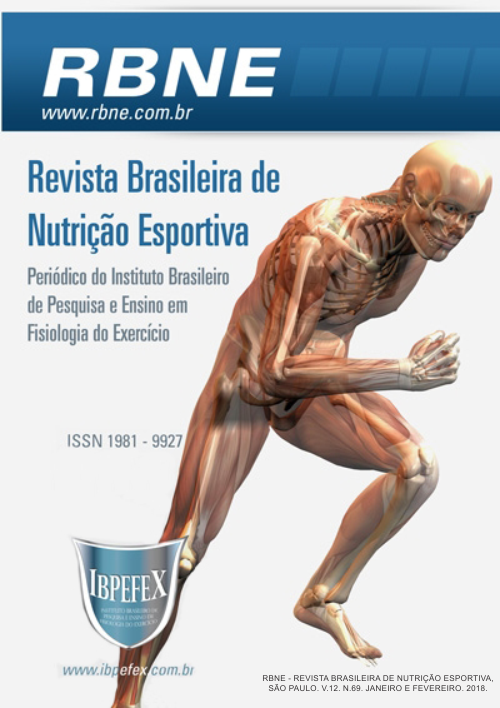Anthropometric profile, use of ergogenic resources and water loss of american football players
Abstract
Introduction: American football consists of a strategic-tatic territory conquest, which takes place in a series of short plays. The good performance of the athletes during a competition will depend on the stability between feeding and training, water and nutrient replacement, determined by the intensity and duration of an event, besides the influence of the ambient temperature and their clothes. Aim: To evaluate the anthropometric profile, the use of ergogenic resources and the water loss of American football players. Materials and Methods: This was a descriptive study conducted with the American football team of Bento Gonçalves, RS. The anthropometric profile (weight, height, body mass index, waist circumference and skinfolds), the use of ergogenic resources and water loss after three days of training were evaluated. Data were tabulated in Excel spreadsheet and analyzed descriptively. Results: 36 players participated in the study. The anthropometric variables classified the majority of the individuals as overweight and the percentage of fat classified as good, as well as the average waist circumference that was found within the normal range. 100% of athletes use maltodextrin and 30.55% use supplementation, mainly protein supplements. In relation to water loss, sufficient hydration was found. Conclusion: The anthropometric profile found can directly affect race performance and performance in training and games. Thus, the importance of nutrition as a fundamental component of the athletes' performance is indicated, as well, as the need for regular evaluations with qualified professionals.
References
-Bass, T. Football Skills & Drills. Champaign. Human Kinetics.2004.
-CFN, Conselho Federal de Nutricionistas. Resolução N° 334/2004. 2004. Disponível em: < http://www.cfn.org.br>. Acesso em: 05/09/16.
-Coritiba Crocodiles. 2016. Disponível em: http://www.coritibacrocodiles.com.br. Acesso em: 04/09/2016.
-Fernandes, W.N.; Machado, J.S. Uso de Suplementos Alimentares por Frequentadores de uma Academia do Município de Passo Fundo-RS. Revista Brasileira de Nutrição Esportiva. Vol. 10. Num. 55. 2016. p. 59-67.Disponível em: <http://www.rbne.com.br/index.php/rbne/article/view/607/527>
-Ferranti, L.T.; Ballard, C.R.; Baratto, I.; Novello, D. Avaliação Nutricional e Consumo Alimentar de Atletas de Rugby. Revista da Universidade Vale do Rio Verde, Três Corações, Vol. 13. Num. 1. 2015. p. 473-485.
-Jackson, A.S.; Pollock, M.L.; Ward, A. Generalized equations for predicting body density of women. Med Sci Sports Exerc. 1980.
-Leão, L.; Rossi, L. Avaliação Hídrica de Atletas de Rugby. Revista Brasileira de Nutrição Esportiva. Vol. 5. Num. 27. 2011.
-Lopes, A.L.; Sant’ana, R.T.; Baroni, B.M.; Cunha, G.S.; Radaelli, R.; Oliveira, A.R.; Castro, F.S. Perfil antropométrico e fisiológico de atletas brasileiros de “rugby”. Revista Brasileira de Educ. Fís. Esporte. Vol. 25. Num. 3. 2011. p. 387-395.
-Mendes, E.L.; Junior, R.A.; Andaki, A.C.R.; Junior, M.M.; Simim, M.A.M.; Mota, G.R. Ergogênicos nutricionais e desempenho no rugby: revisão sistemática. Arquivos de Ciências do Esporte. Vol. 2. Num. 1. 2015.
-Naves, A.C.V.S.; Isizuka, K.M.; Ruas, M.O.; Ramada, R.A.; Nacif, M. Avaliação Nutricional de Jogadores de Rugby. Revista Brasileira de Nutrição Esportiva. Vol. 10. Num. 60. 2016. p. 612-618. Disponível em: <http://www.rbne.com.br/index.php/rbne/article/view/702/589>
-Oliveira, S.F.; Riboldi, B.P.; Alves, M.K. Conhecimento sobre Nutrição Esportiva, uso e indicação de suplementos alimentares por educadores físicos de Caxias do Sul-RS. RBNE-Revista Brasileira de Nutrição Esportiva, Vol. 11. Num. 62. 2017. p. 141-149. Disponível em: <http://www.rbne.com.br/index.php/rbne/article/view/745/616>
-Perrella, M. M.; Noriyuk, P. S.; Rossi, L. Avaliação da perda hídrica durante treino intenso de rugby. Revista Brasileira de Medicina do Esporte. Vol. 11. Num. 4. 2005. p. 229-232.
-Pinto, S.I.F.; Berdacki, V.A.; Biesek, S. Avaliação da perda hídrica e do grau de conhecimento em hidratação de atletas de futebol americano. Revista Brasileira de Nutrição Esportiva. Vol. 8. Num. 45. 2014. p. 171-179. Disponível em: <http://www.rbne.com.br/index.php/rbne/article/view/454/418>
-Rondinelli, P. Futebol Americano. Brasil Escola. Disponível em <http://brasilescola.uol.com.br/educacao-fisica/futebol-americano.htm>. Acesso em 05/09/2016.
-Schneider, P.; Benedetti, G.; Meyer, F. Força muscular de atletas de voleibol de 9 a 18 anos através da dinamometria computadorizada. Rev Bras Med Esporte. Vol. 10. Num. 2004. p. 85-91.
-Schneider, L.; Bennemann, G. D.; Ballard, C. R.; Trindade, M. C. C. Avaliação de conhecimentos em nutrição e de hábitos alimentares por profissionais educadores físicos no município de Guarapuava-Paraná. Revista Brasileira de Nutrição Esportiva, v. 8. Núm. 43. 2014. p. 65-73. Disponível em: <http://www.rbne.com.br/index.php/rbne/article/view/430/402>
-Vieira, A.C.S.; Biesek, S. Avaliação do consumo de recursos ergogênicos nutricionais por praticantes de artesmarciais em uma academia da cidade de Curitiba-PR. Revista Brasileira de Nutrição Esportiva. Vol. 9. Num. 53. 2016. p. 454-462. Disponível em: <http://www.rbne.com.br/index.php/rbne/article/view/572/501>
Authors who publish in this journal agree to the following terms:
- Authors retain the copyright and grant the journal the right of first publication, with work simultaneously licensed under the Creative Commons Attribution License BY-NC which allows the sharing of the work with acknowledgment of the authorship of the work and initial publication in this journal.
- Authors are authorized to enter into additional contracts separately for non-exclusive distribution of the version of the work published in this journal (eg, publishing in institutional repository or book chapter), with acknowledgment of authorship and initial publication in this journal.
- Authors are allowed and encouraged to post and distribute their work online (eg, in institutional repositories or on their personal page) at any point before or during the editorial process, as this can bring about productive change as well as increase impact and impact. citation of published work (See The Effect of Free Access).






